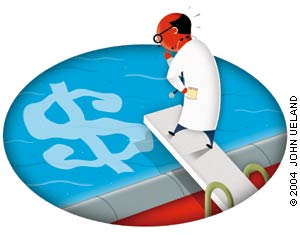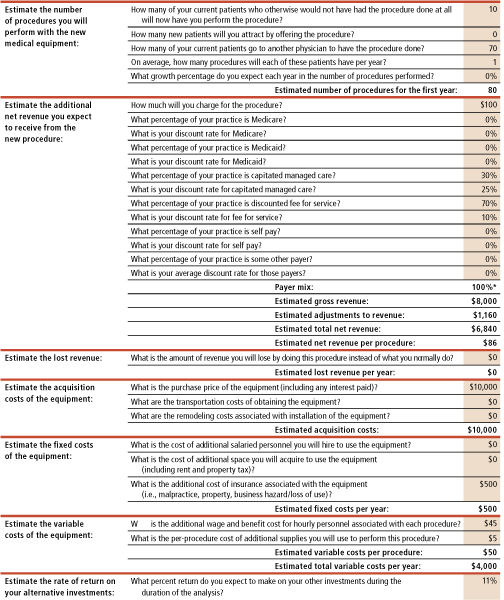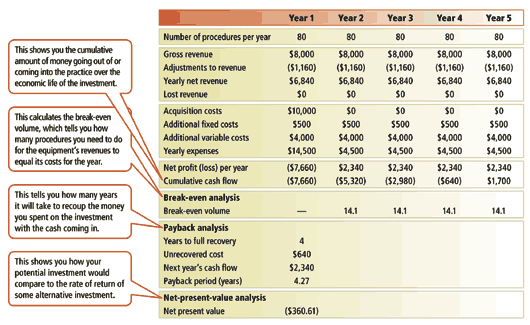
These tips and tools will help you determine whether this type of investment will be beneficial to your practice.
Fam Pract Manag. 2004;11(3):53-58

With shrinking profit margins in primary care medicine, deciding how to invest a practice’s precious capital resources is becoming more difficult. Purchasing procedural medical equipment is something many physicians may consider, and sales representatives for the equipment can always make the investment sound enticing. But how do you really know if the investment will be beneficial to you – financially or otherwise?
Whether you’re looking to purchase equipment for your own practice or you’re interested in convincing your employer purchase equipment, this article will walk you through the decision-making process and provide you with tools to help you analyze the financial impact of such an investment. To illustrate how the decision-making process and analysis tools work, the potential investment in a flexible sigmoidoscope is used throughout the article as an example. Keep in mind, however, that the same process and tools can be used to evaluate any type of medical equipment.
KEY POINTS
Before you conduct a financial analysis on a potential investment, you need to evaluate the nonfinancial aspects of it.
The data you gather for a financial analysis should identify the incremental (additional) cash flows related to the investment.
Specific financial analyses can show you the short- and long-term implications of the investment and the time it will take for the investment to pay itself off.
Nonfinancial evaluation
Before you consider the financial impact of any potential investment, you need to evaluate the nonfinancial aspects of it. This is especially important for investments that do not directly generate revenue, since the nonfinancial considerations of these investments may weigh more heavily on your decision. (See “Non-revenue-generating investments.”) Ask yourself the following questions:
Does this investment fit with the practice’s overall business strategy, goals and imperatives? For example, if your business strategy is to focus on attracting younger patients, updating your waiting room and adding a play area may be more strategically in line with your business plan than buying a flexible sigmoidoscope, even if purchasing the scope would be financially beneficial for your practice. Or if your practice is trying to improve immunization rates or reschedule patients because one of your physicians needs unexpected leave, investing in these goals and imperatives may be more beneficial to your practice than investing in new medical equipment. If you do decide to conduct a financial evaluation, it’s important to keep your ultimate goals for the investment (e.g., to increase revenue and/or quality) in mind when you get to the point of making a purchase decision.
What are the pros and cons of the investment? This question may uncover some significant issues that would make a financial analysis unnecessary. For example, if colonoscopy replaces flexible sigmoidoscopy as the procedure of choice for colon cancer screening, purchasing sigmoidoscopy equipment would not be a good investment.
What alternative investment opportunities does the practice have? When considering a significant investment for your practice, it’s important to also consider other ways you could use the money and which investment opportunity would be the best fit for the practice overall. For example, instead of purchasing a flexible sigmoidoscope, you might consider whether you would benefit more from expanding your office space by two exam rooms.
If the conclusions you reach after asking yourself these three questions support the investment in new medical equipment and if the investment is above a threshold dollar amount (typically $1,000 for a small group practice), the next step is for you to conduct a complete financial analysis on the investment.
NON-REVENUE-GENERATING INVESTMENTS
In most medical practices, frequent decisions must be made about investments that do not directly generate revenue. How do you evaluate the finances of these decisions? Unfortunately, there is no easy answer. If the investment is large, such as an electronic medical record (EMR) system, conducting a financial analysis to quantify the related revenues (e.g., increased charges due to better documentation), costs (e.g., software, hardware, training) and cost savings (e.g., less staff time spent looking for charts, lower photocopy expenses) can be worthwhile. And even for some smaller investment opportunities, doing a financial analysis to quantify the financial impact of the investment on the practice is still important, although the decision may need to be made on the basis of nonfinancial considerations.
Financial evaluation
A complete financial analysis involves gathering all of your pertinent financial information into one place and then using that data to analyze the feasibility of a particular investment. Simply gathering the data will help you to identify the estimated incremental cash flows related to the investment (the additional expenses and revenues that you will see as a result of the investment), which can show you how a particular investment will improve your overall business performance rather than just whether a particular investment will make a profit on its own. Though many physicians who are evaluating a potential investment for their practice will stop here, it’s important to further analyze this data with a break-even analysis, a payback analysis and a net-present-value analysis. These analyses can show you the short- and long-term financial implications of the investment and the length of time it will take for the investment to pay itself off. While conducting one financial analysis on a potential investment may be adequate in some cases, in others you might get the most complete financial perspective by conducting the analysis three times using data estimations based on “worst case,” “most likely” and “best case” scenarios.
Gathering the data
The worksheet below is derived from an Excel workbook that can be downloaded. If you can collect the information shown in the tinted boxes of the worksheet and enter it into the corresponding page of the workbook, Excel can do a basic analysis for you. Here is what you need.
Number of procedures. To estimate the revenues for procedural medical equipment, you’ll need to estimate the number of procedures that will be performed with the new equipment. This estimate should take into account (1) new procedures that will be performed on your current patients by you instead of someone outside of the practice, (2) new procedures that are indicated but aren’t otherwise being performed on your current patients, (3) new procedures that will be performed on new patients attracted to your practice by the availability of the new procedure, and (4) the number of procedures each of these patients would have per year.
For example, you may estimate that the number of patients per year you currently send to the gastroenterologist for a flexible sigmoidoscopy is 70, the number of your patients who don’t bother going to the gastroenterologist but will have the procedure done by you in your office is 10, the number of new patients you expect to attract each year because of the new procedure is zero since flexible sigmoidoscopy is already offered by a number of primary care doctors in your area, and each of these patients would only have the procedure done once every five years. In this example, the estimated number of procedures per year would be (70 + 10 + 0) x 1 = 80.
When looking at an investment over a period of several years, you will want to consider whether you expect the number of procedures to change each year for any reason and make adjustments in the numbers. Also note that if this analysis covered more than five years, a significant number of the patients you will have already tested will need to be tested again, so you would need to factor that into your estimate as well.
The worksheet will calculate gross revenue, net revenue and net revenue per procedure using information you enter. You’ll need to determine how much you’ll charge for the procedure and estimate the percentage of your practice that each major payer type accounts for, as well as the percentage by which each payer discounts your services.
Lost revenue. When a new procedure is added, you need to consider whether any revenue will be lost from other activities that this procedure will replace. If you would be doing these procedures during a time when you would normally be seeing patients in a clinic, for example, you would need to consider the offsetting loss of patient care revenue. To calculate the lost patient care revenue, you need to estimate the number of patients you could otherwise see during the time you expect to spend performing the new procedures. For the sake of simplicity, the example assumes that you would be doing flexible sigmoidoscopies during a time when you would not normally be seeing patients.
Capital, fixed and variable costs. Capital costs, or acquisition costs, are those associated with obtaining the equipment, such as the purchase price of the equipment (including any interest paid), the transportation costs to receive the equipment and the remodeling costs required for the equipment. Fixed costs are those that do not vary in the short term (e.g., property tax, rent, salaries, insurance). Variable costs are those that vary as the volume of activity changes (e.g., supplies, hourly personnel). Differentiating between fixed and variable costs becomes a little trickier when “mixed” or “step” costs are involved. Mixed or step costs are those that contain some characteristics of both fixed and variable costs. For example, if you’re adding an hourly medical assistant to help with the new procedure, you’ll need to classify the costs associated with hiring the person (e.g., licensing fees) as fixed costs and the hours they spend helping with the procedure as variable costs.
Rate of return. This is the percentage gain or percentage loss on an investment over a specified period of time. For this type of financial analysis, it’s best to use the rate of return you expect on some other investments if you know what that is; otherwise, you can use 11 percent, which is the U.S. stock market’s long-term rate of return, as a default.
FINANCIAL ANALYSIS WORKSHEET
This worksheet, which has been completed using data from the flexible sigmoidoscope example in the article, is derived from an Excel workbook that can be downloaded below. If you can collect the information shown in the tinted boxes of the worksheet and enter it into the corresponding page of the workbook, Excel can do a basic analysis for you, as shown in the table.

Analyzing the data
Once the worksheet page of the Excel workbook is complete, you can turn to the Analysis page of the workbook to see the results, as depicted below. Here’s what’s involved in the analyses performed and how to interpret the results.
Net profit or loss/cumulative incremental cash flow calculations. The net profit or loss for each year is the net revenue for the year minus the expenses and lost revenue for the year. The cumulative cash flow for year one is equal to the net profit or loss for year one. Then, for year two, it’s the cumulative cash flow for year one plus the net profit or loss for year two, and so on throughout the analysis.
Break-even analysis. This is essentially a one-year snapshot of the profitability of an investment. It calculates the break-even volume, which tells you how many procedures you need to do for the equipment’s revenues to equal its costs on an annual basis. At volumes less than the break-even volume, you could expect a financial loss; at volumes greater than the break-even volume, you could expect a financial profit. This analysis allows you to look at your expected volume of procedures in the future to see whether you can expect a profit in a given year. And continuing to conduct the analysis every six to 12 months can help you ensure that you are using the new equipment enough to at least break even as your expenses (e.g., nursing staff salary and fringe benefits) increase over time. The break-even volume equals the total fixed costs of an investment divided by the difference between the net revenue per procedure and the variable costs per procedure.
Note that the break-even volume in year one would be quite high if the acquisition costs were allocated to the first year, as in our example. In such cases, the year-two break-even analysis is more helpful. In cases where the costs are spread out over the years, conducting a break-even analysis for year one can be useful.
Payback analysis. This tells you how many years it will take to recoup the money you spent on the investment with the cash coming in (assuming your cash-flow estimates are correct). This analysis involves the yearly net revenue from the equipment, the cost of the investment and the economic life of the equipment, which is the number of years over which revenue is expected as a consequence of the investment. Even if revenue is expected indefinitely, a maximum economic life should be set due to the uncertainty of cash inflow in the distant future. Generally, the economic life of a piece of equipment is equal to the number of years until the equipment wears out, typically three to five years for most equipment used in office procedures. This number determines the duration of the financial analysis.
The payback period takes into account the number of years during which the cumulative cash flow is negative (the “number of years before full recovery”), the negative amount of cumulative cash flow left over that year (the “unrecovered cost”) and the net profit or loss per year for the following year (the “next year’s cash flow”) to show you how long it will take to get your money back on the investment. If the payback period is greater than or equal to the economic life of the equipment, the investment is not financially advisable; if it is significantly less than the economic life of the equipment, the investment is probably worth making.
Net-present-value analysis. Based on the concept that money now and money in the future cannot be directly compared with one another, the net-present-value analysis subtracts the value of what all of the cash coming in to you from the investment would be worth today from the value of what all the costs and expenses of the investment would be worth today and shows you how your potential investment would compare to the rate of return of some alternative investment. This type of analysis, which helps you to decide which investment would provide the most value to your practice in the future, is useful when there is an initial lump sum investment at the beginning of a project followed by a stream of revenue over a period of years in the future, as is the case with medical equipment.
This can be illustrated with the flexible sigmoidoscopy example. Let’s say you decide to buy the equipment and one salesperson offers it to you for $10,500 with an interest-free loan for one year and another offers it to you for $10,000 with payment in full upon delivery. If you took $10,000 and invested it at 5-percent interest for one year, it would be worth $10,500 ($10,000 is the present value of $10,500 one year from now with a 5-percent interest rate). There fore, to get a better deal from the second salesperson, you would have to negotiate down below $10,000. Otherwise, you would buy the scope from the first salesperson.
Assuming that calculus isn’t something you do every day, it’s much easier to let Excel calculate this for you. You’ll need to enter the rate of return and the net profit or loss for each year of the analysis. If the net present value is negative, as it is in the flexible sigmoidoscopy example, the alternate investment may be more financially beneficial to your practice than the investment you’re considering.
FINANCIAL ANALYSIS RESULTS
The table below shows the results of the flexible sigmoidoscope analysis. The Excel workbook that can be downloaded generates this analysis using data you enter in a worksheet. The payback period in the example is 4.27 years, which is not significantly less than the equipment’s maximum economic life of three to five years, and the net present value is $-360.61. The negative net present value implies that investing the money in the stock market may be more financially beneficial than purchasing the flexible sigmoidoscope if all of the assumptions in the analysis hold true. Unless there are significant nonfinancial reasons to buy the flexible sigmoidoscope, this analysis suggests that the practice should consider other investment opportunities.

The bottom line
Simply put, deciding whether an investment in new medical equipment will be beneficial to your practice involves evaluating how it fits with your overall business plan, how it compares to alternative investment opportunities in your practice and whether it will make a profit on its own and improve your practice’s overall financial performance now and in the future. Note that if this is your first attempt at financial analysis, you should consult with an accountant or other financial adviser before making an invesment decision. Gathering all of the financial information necessary in a financial evaluation takes some effort, but knowing how an investment opportunity might impact your practice’s financial performance can be well worth the effort.